1988 PONTIAC FIERO automatic transmission fluid
[x] Cancel search: automatic transmission fluidPage 1116 of 1825
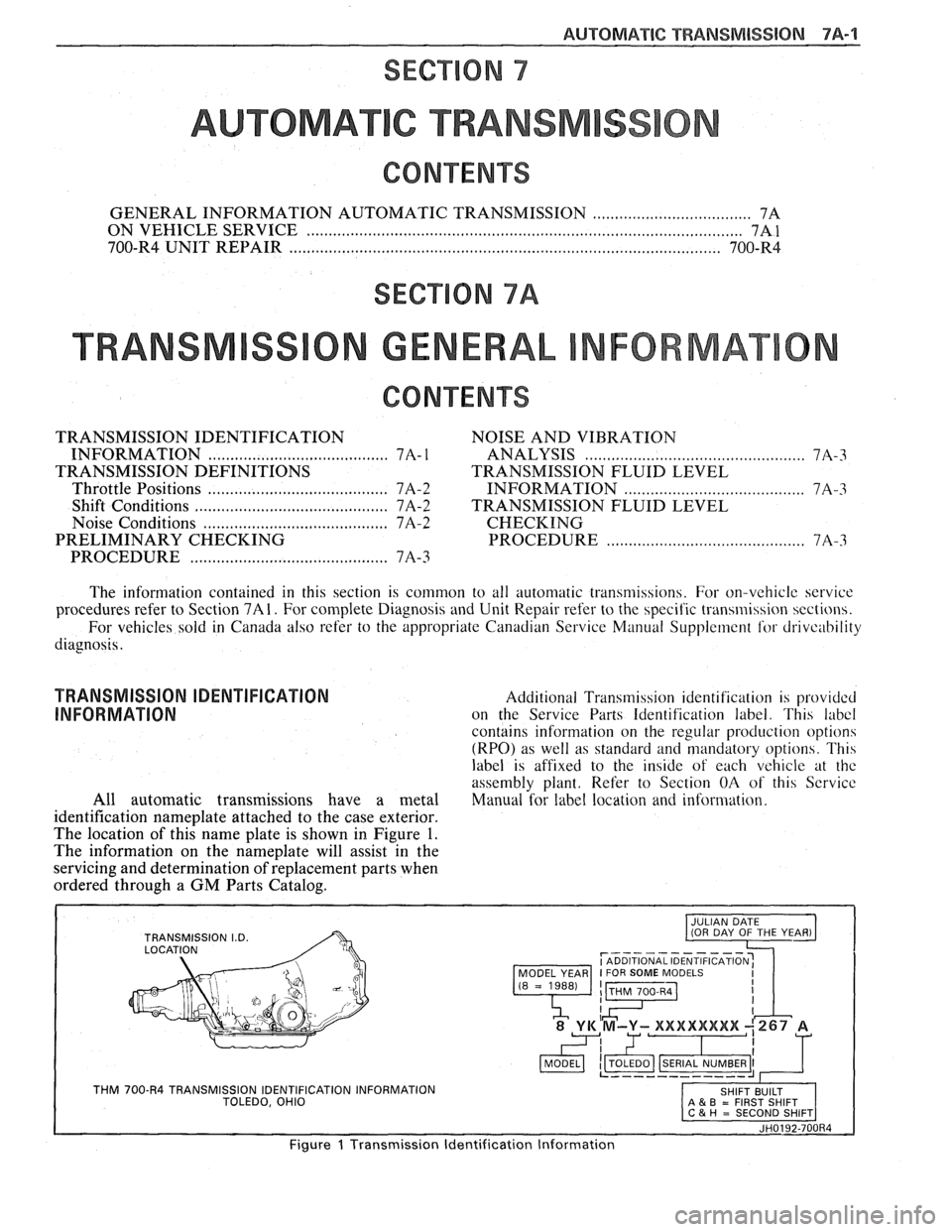
AUTOMATIC TRANSMISSION 7A-1
SECTION 7
AUTOMAT C TRANSM
CONTENTS
GENERAL INFORMATION AUTOMATIC TRANSMISSION .................................... 7A
ON VEHICLE SERVICE .................................................................................................. 7A 1
700-R4 UNIT REPAIR .................................................................................................. 700-R4
SECTION 7A
TRANSM ON GENERAL NFORMAT
CONTENTS
TRANSMISSION IDENTIFICATION NOISE AND VIBRATION
INFORMATION
..................... .. .............. 7A- I ANALYSIS .................... .... .............. 7A-3
TRANSMISSION DEFINITIONS TRANSMISSION FLUID LEVEL
Throttle Positions
.......................... .. ..... 7A-2 INFORMATION ....................................... 7A-3
Shift Conditions .................................... .... . 7A-2 TRANSMISSION FLUID LEVEL
Noise Conditions
....................................... 7A-2 CHECKING
PRELIMINARY CHECKING PROCEDURE
............................................ 7A-3
PROCEDURE
......................................... 7A-3
The information contained in this section is common to all automatic transn~issions. For on-vehicle service
procedures refer to Section
7A1. For complete Diagnosis and Unit Repair refer to the specific transrllission sections.
For vehicles sold in Canada also refer to the appropriate Canadian Service Manual Supplement for-
driveuhility
diagnosis.
TRANSMISSION IDENTIFICATION Additional Transmibsion identification is pr-ov~dcd
INFORMATION on the Service Parts Identification label. This labcl
contains information on the regular production option
(RPO) as well as standard and mandatory options. Th14
label is affixed to the inde of each vehrcle at thc
assembly plant. Refer to Section OA of this Scrvice
All automatic transmissions have a metal Manual for label location and information.
identification nameplate attached to the case exterior.
The location of this name plate is shown in Figure
1.
The information on the nameplate will assist in the
servicing and determination of replacement parts when
ordered through a GM Parts Catalog.
r----------- I ADDITIONAL IDENTIFICATION: MODEL YEAR I FOR SOME MODELS
THM 700-R4 TRANSMISSION IDENTIFICATION INFORMATION TOLEDO, OHIO A & B = FIRST SHIFT
JH0192-700R4
Figure 1 Transmission Identification Information
Page 1118 of 1825
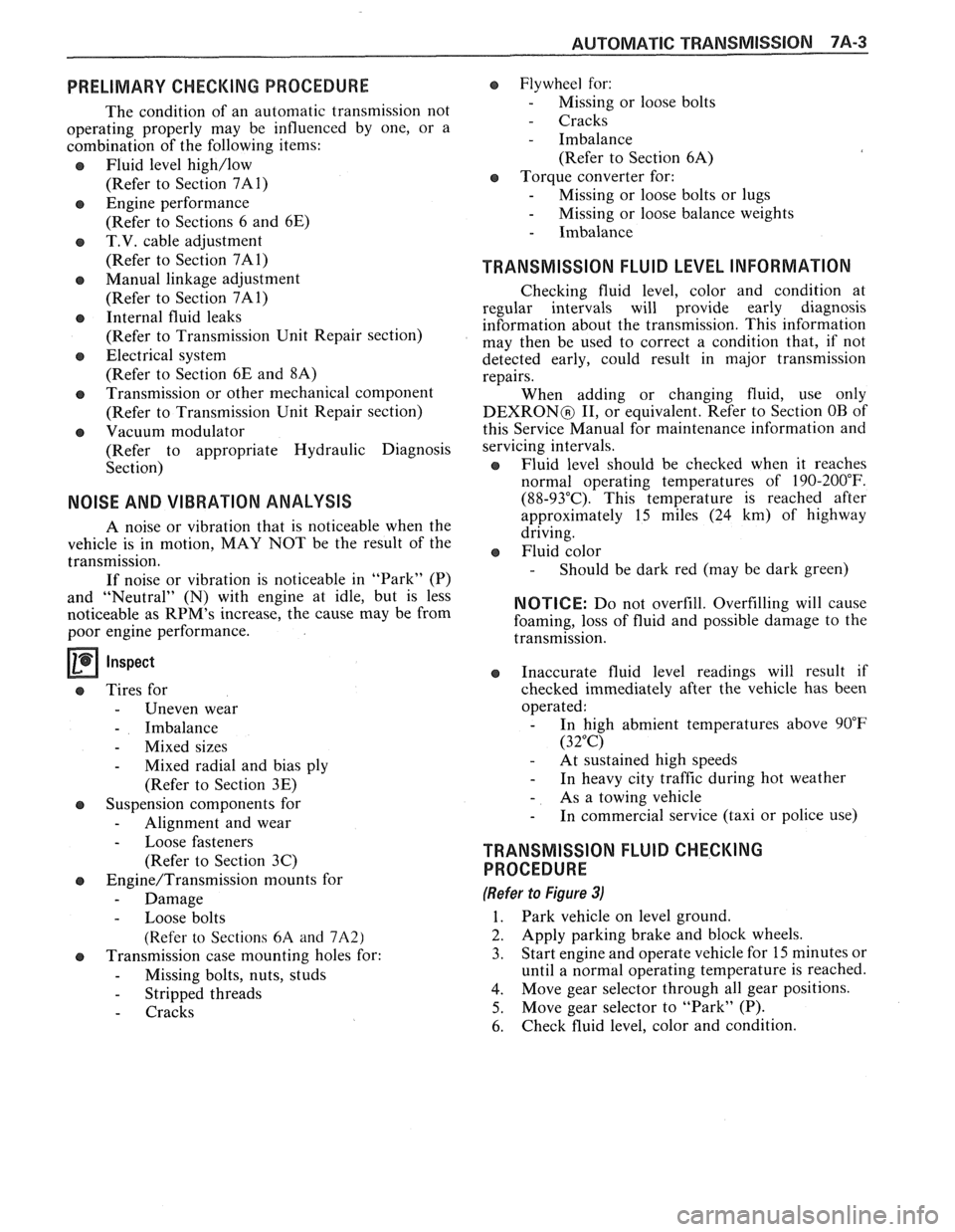
AUTOMATIC TRANSMISSION 7A-3
PRELIMARY CHECKING PROCEDURE
The condition of an automatic transmission not
operating properly may be influenced by one, or a
combination of the following items:
e Fluid level high/low
(Refer to Section 7A1)
e Engine performance
(Refer to Sections 6 and 6E)
T.V. cable adjustment
(Refer to Section
7A1)
e Manual linkage adjustment
(Refer to Section
7A1)
e Internal fluid leaks
(Refer to Transmission Unit Repair section)
e Electrical system
(Refer to Section 6E and 8A)
e Transmission or other mechanical component
(Refer to Transmission Unit Repair section)
e Vacuum modulator
(Refer to appropriate Hydraulic Diagnosis
Section)
NOISE AND VIBRATION ANALYSIS
A noise or vibration that is noticeable when the
vehicle is in motion, MAY NOT be the result of the
transmission.
If noise or vibration is noticeable in "Park"
(P)
and "Neutral" (N) with engine at idle, but is less
noticeable as
RPM's increase, the cause may be from
poor engine performance.
e Tires for
- Uneven wear
- Imbalance
- Mixed sizes
- Mixed radial and bias ply
(Refer to Section 3E)
e Suspension components for
- Alignment and wear
- Loose fasteners
(Refer to Section 3C)
e Engine/Transmission mounts for
- Damage
- Loose bolts
(Refer
to Sections 6A and 7A2)
e Transmission case mounting holes for:
- Missing bolts, nuts, studs
- Stripped threads
- Cracks
e Flywheel for:
- Missing or loose bolts
- Cracks
- Imbalance
(Refer to Section 6A)
e Torque converter for: - Missing or loose bolts or lugs - Missing or loose balance weights
- Imbalance
TRANSMISSION FLUID LEVEL INFORMATION
Checking fluid level, color and condition at
regular intervals will provide early diagnosis
information about the transmission. This information
may then be used to correct a condition that, if not
detected early, could result in major transmission
repairs.
When adding or changing fluid, use only
DEXRONO 11, or equivalent. Refer to Section OB of
this Service Manual for maintenance information and
servicing intervals.
Fluid level should be checked when it reaches
normal operating temperatures of
190-200°F.
(88-93°C). This temperature is reached after
approximately 15 miles (24 km) of highway
driving.
e Fluid color - Should be dark red (may be dark green)
NOTICE: Do not overfill. Overfilling will cause
foaming, loss of fluid and possible damage to the
transmission.
Inaccurate fluid level readings will result if
checked immediately after the vehicle has been
operated:
- In high abmient temperatures above 90°F
(32°C)
- At sustained high speeds
- In heavy city traffic during hot weather
- As a towing vehicle - In commercial service (taxi or police use)
TRANSMISSION FLUID CHECKING
PROCEDURE
(Refer to Figure 3)
1. Park vehicle on level ground.
2. Apply parking
brake and block wheels.
3. Start
engine and operate vehicle for 15 minutes or
until a normal operating temperature is reached.
4. Move gear
selector through all gear positions.
5. Move
gear selector to "Park" (P).
6. Check fluid level, color and condition.
Page 1119 of 1825
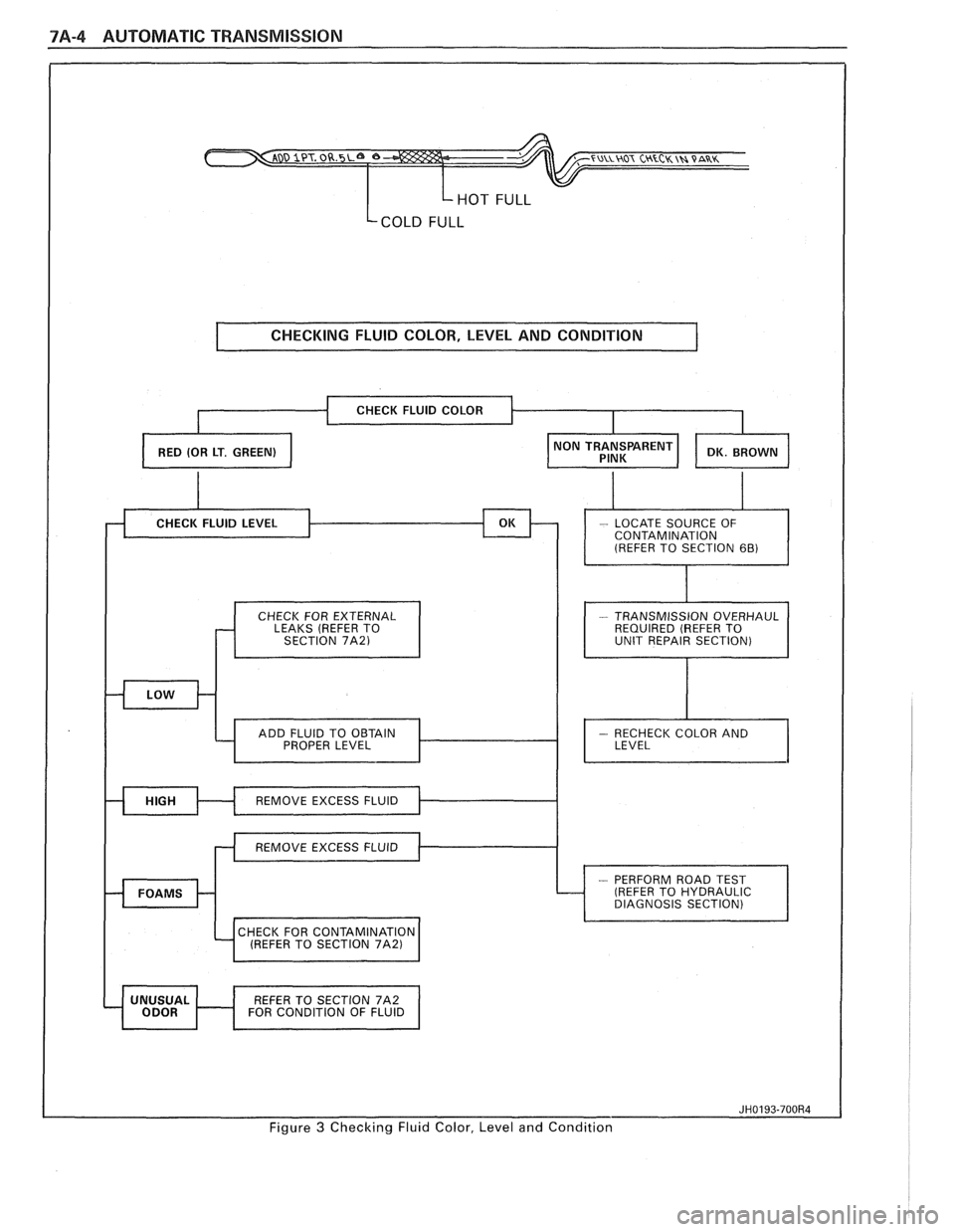
7A-4 AUTOMATIC TRANSMISSION
HOT FULL
Lcom FULL
I CHECKING FLUID COLOR, LEVEL AND CONDITION 1
CHECK FOR EXTERNAL
LEAKS (REFER TO
SECTION
7A21 I I
- TRANSMISSION OVERHAUL
REQUIRED (REFER TO
UNIT REPAIR SECTION)
I
CHECK FOR CONTAMINATION 4 (REFER TO SECTION 71\21 1
REFER TO SECTION 7A2
FOR CONDITION OF FLUID I
Figure 3 Checking Fluid Color, Level and Condition
Page 1120 of 1825

AUTOMATIC TMNSMISSION ON-VEHICLE SERVICE 7A1-1
SECTION 7Al
AUTOMAT C TRANSM
ON VEH CLE SERV
CONTENTS
GENERAL SERVICE T.V. Cable
PROCEDURES Diagnosis ........................ .. ....................... 7A 1-6
Parts Cleaning, Inspection and
Replacement
....................................... 7A1-7
Replacement
............................ ... .... 7A1- 1 Adjustment ............................................. 7A1-7
Flexplate/Torque Converter Changing Fluid and Filter ............................. 7A1-7
........................... Vibration Test Procedure 7A1-2 700-R4 Serviceable Components
Fluid Leak Diagnosis
..................................... 7A 1-2
Servo Assembly .......................................... 7A 1-7
Methods For Locating Leaks
.................... 7Al-2 Speedometer Drive Gear .............................. 7A 1-1 1
Repairing the Leak .................................. 7A 1-2 Spccdomctcr Driven Gciu .......................... 7A1-1 1 Possible Points of Fluid Leaks .................. 7A1-2 Governor ............................................. 7A 1- 1 1
Case Porosity Repair .................................. 7A 1-3 Filler Tube .............................................. 7A1-12
Torque Converter Clutch
Pressure Regulator Valve
........................... 7A 1- 12
Electrical Controls
.................................. 7Al-3
Auxiliary Valve Body ................................. 7A1-13
Diagnosis
................................... .... ........ 7A 1-3 Valve Body ............................................. 7A 1- 13
ON-VEHICLE SERVICE Rear Oil Seal ............................................ 7A 1- 14
Shift Control Cable
Oil Cooler Lines And Fittings
................... 7A1-14
Replacement
............................................ 7A 1-3 Oil Cooler Flushing .............................. 7A 1 - 14 ................................................ Adjustment 7A1-3 Transmission Assenlbly Removal and
Floor Shift Control
................... .. ................ 7A1-3
Installation ........................... .. ............ 7A1- 14
Park/Lock Control Cable .............................. 7A 1-4
Park/Neutral and Back Up Lamp
Switch
................................................. 7A1-5
GENERAL SERVICE PROCEDURES
PARTS CLEANING, INSPECTION AND
REPLACEMENT
Use appropriate safety equipment such as:
- Safety glasses
- Safety shoes
- Gloves
Keep work area and tools clean
Clean transmission exterior before removing
parts
Do not use wipe cloths or rags
Do not use solvents on:
- Rubber seals
- Plastic/Teflon@ thrust washers
Blow out all passages with compressed air
Clean out small passages with fine wire
Handle parts carefully to prevent damage
Lubricate all internal parts with transmission
fluid during assembly
When installing screws, bolts or studs into
aluminum always dip the threads in transmission
fluid
Always use a torque wrench for proper torque
€3 Recondition damaged or stripped aluminum
threads with thread inserts
@ Replace all gaskets and o-ring seals
- Do not use gasket cement or sealers
@ Replace Teflon@ and rubber lip seals only when
necessary and install using the appropriate seal
protector
s Manual linkage for:
- Wear at pivoting points - Bent or broken links and rods
s All seals, gaskets, o-rings and mating surfaces for:
- Nicks
- Cuts
- Damage
€3 Snap rings for:
- Expansion or compression
- Distortion
- Nicks
- Proper ring to groove fit
s Bearings and thrust surfaces for:
- Wear
- Scoring
Page 1121 of 1825
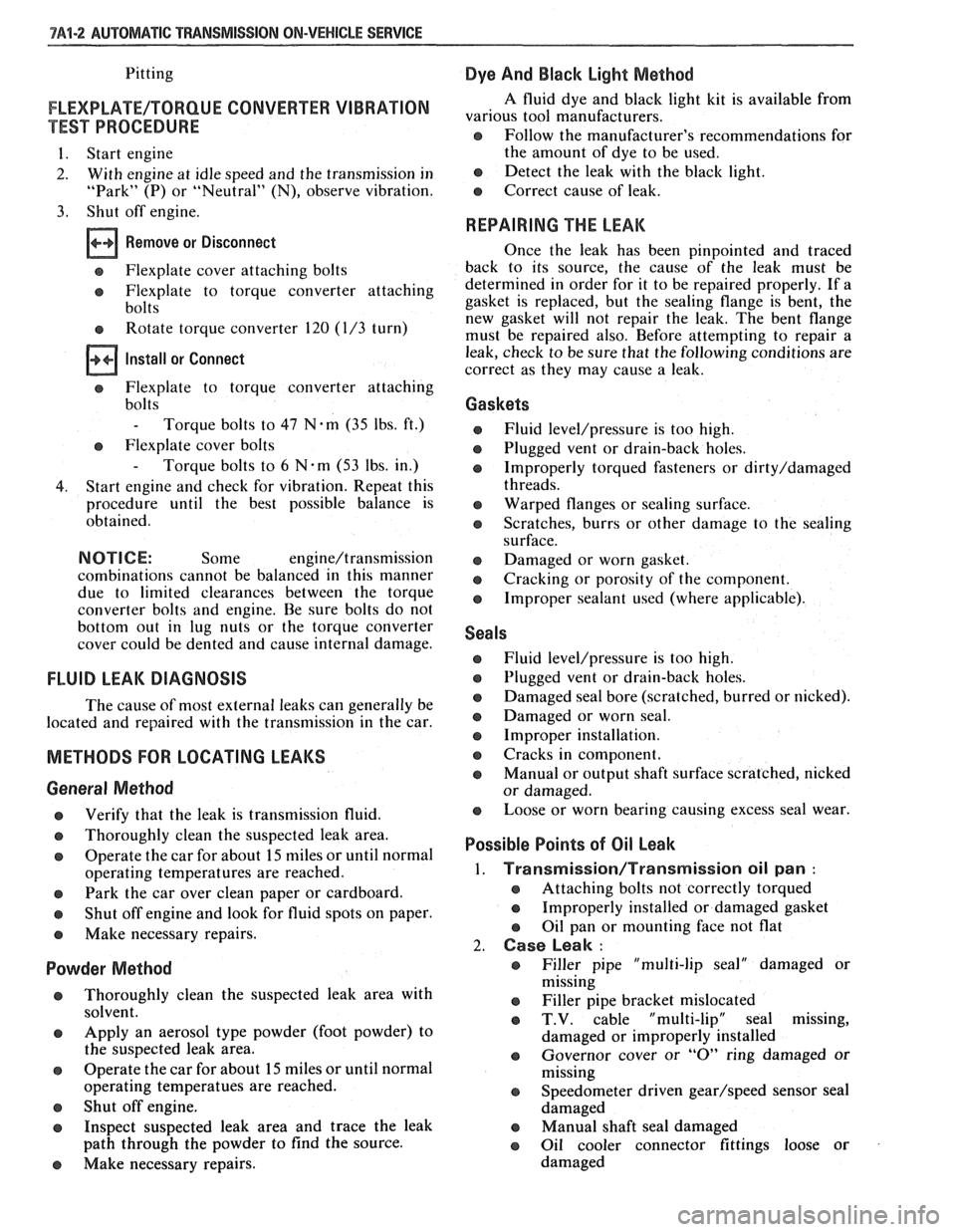
7A1-2 AUTOMATIC TRANSMISSION ON-VEHICLE SERVICE
Pitting
FLEXPLATE/TORQUE CONVERTER VIBRATION
TEST PROCEDURE
1. Start engine
2. With engine at idle speed and the transmission in
"Park"
(P) or "Neutral" (N), observe vibration.
3. Shut off engine.
Remove or Disconnect
e Flexplate cover attaching bolts
s Flexplate to torque converter attaching
bolts
e Rotate torque converter 120 (1/3 turn)
Install
or Connect
e Flexplate to torque converter attaching
bolts
- Torque bolts to 47 N.m (35 Ibs. ft.)
s Flexplate cover bolts
- Torque bolts to 6 N-m (53 lbs. in.)
4. Start engine and check for vibration. Repeat this
procedure un
ti1 the best possible balance is
obtained.
NOTICE: Some engine/transmission
combinations cannot be balanced in this manner
due to limited clearances between the torque
converter bolts and engine. Be sure bolts do not
bottom out in lug nuts or the torque converter
cover could be dented and cause internal damage.
FLUID LEAK DIAGNOSIS
The cause of most external leaks can generally be
located and repaired with the transmission in the car.
METHODS FOR LOCATING LEAKS
General Method
s Verify that the leak is transmission fluid.
a Thoroughly clean the suspected leak area.
s Operate the car for about 15 miles or until normal
operating temperatures are reached.
e Park the car over clean paper or cardboard.
s Shut off engine and look for fluid spots on paper.
a Make necessary repairs.
Powder Method
e Thoroughly clean the suspected leak area with
solvent.
a Apply an aerosol type powder (foot powder) to
the suspected leak area.
s Operate the car for about 15 miles or until normal
operating temperatues are reached.
s Shut off engine.
e Inspect suspected leak area and trace the leak
path through the powder to find the source.
a Make necessary repairs.
Dye And Black Light Method
A fluid dye and black light kit is available from
various tool manufacturers.
s Follow the manufacturer's recommendations for
the amount of dye to be used.
a Detect the leak with the black light.
e Correct cause of leak.
REPAIRING THE LEAK
Once the leak has been pinpointed and traced
back to its source, the cause of the leak must be
determined in order for it to be repaired properly. If a
gasket is replaced, but the sealing flange is bent, the
new gasket will not repair the leak. The bent flange
must be repaired also. Before attempting to repair a
leak, check to be sure that the following conditions are
correct as they may cause a leak.
Gaskets
s Fluid level/pressure is too high.
e Plugged vent or drain-back holes.
s Improperly torqued fasteners or dirty/damaged
threads.
a Warped flanges or sealing surface.
e Scratches, burrs or other damage to the sealing
surface.
e Damaged or worn gasket.
e Cracking or porosity of the component.
s Improper sealant used (where applicable).
Seals
e Fluid level/pressure is too high.
a Plugged vent or drain-back holes.
s Damaged seal bore (scratched, burred or nicked).
e Damaged or worn seal.
e Improper installation.
a Cracks in component.
e Manual or output shaft surface scratched, nicked
or damaged.
a Loose or worn bearing causing excess seal wear.
Possible Points of Oil Leak
I. Transmission/Transmission oil pan :
Attaching bolts not correctly torqued
s Improperly installed or damaged gasket
s Oil pan or mounting face not flat
2, Case Leak :
@ Filler pipe "multi-lip seal" damaged or
missing
a Filler pipe bracket mislocated
s T.V. cable "multi-lip" seal missing,
damaged or improperly installed
a Governor cover or "0" ring damaged or
missing
@ Speedometer driven gear/speed sensor seal
damaged
e Manual shaft seal damaged
s Oil cooler connector fittings loose or
damaged
Page 1122 of 1825
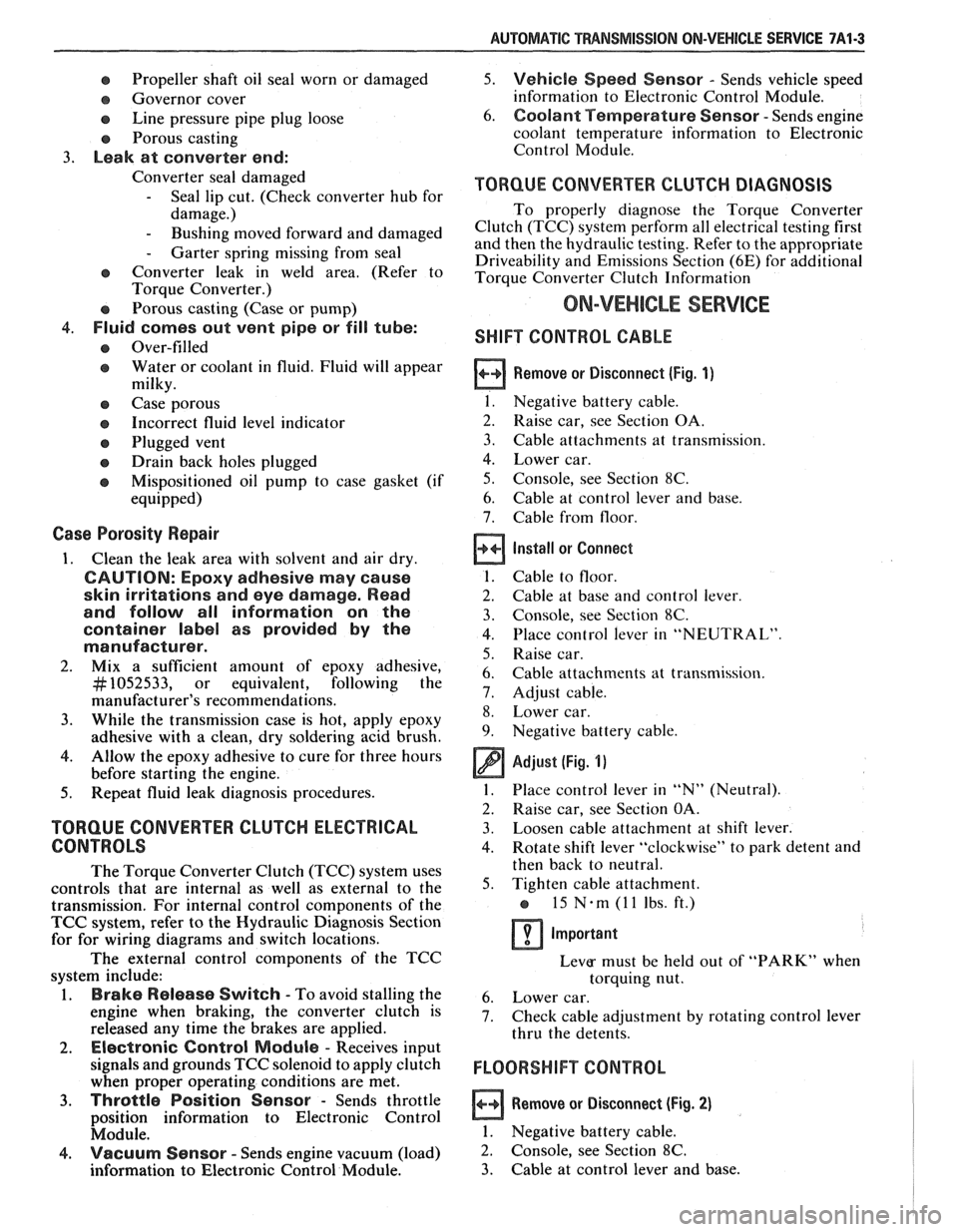
AUTOMATIC TMNSMISSION ON-VEHICLE SERVICE 7A1-3
e Propeller shaft oil seal worn or damaged
o Governor cover
e Line pressure pipe plug loose
@ Porous casting
3. Leak at converter end:
Converter seal damaged
- Seal lip cut. (Check converter hub for
damage.)
- Bushing moved forward and damaged
- Garter spring missing from seal
o Converter leak in weld area. (Refer to
Torque Converter.)
Porous casting (Case or pump)
4. Fluid comes out vent pipe or fill tube:
Over-filled
Water or coolant in fluid. Fluid will appear
milky.
e Case porous
e Incorrect fluid level indicator
e Plugged vent
e Drain back holes plugged
Mispositioned oil pump to case gasket (if
equipped)
Case Porosity Repair
1. Clean the leak area with solvent and air dry.
CAUTION: Epoxy adhesive may cause
skin irritations and eye damage. Read
and follow all information on the
container label as provided by the
manufacturer.
2. Mix a sufficient amount of epoxy adhesive,
# 1052533, or equivalent, following the
manufacturer's recommendations.
3. While the transmission case is hot, apply epoxy
adhesive with a clean, dry soldering acid brush.
4. Allow the epoxy adhesive to cure for three hours
before starting the engine.
5. Repeat fluid leak diagnosis procedures.
TORQUE CONVERTER CLUTCH ELECTRICAL
CONTROLS
The Torque Converter Clutch (TCC) system uses
controls that are internal as well as external to the
transmission. For internal control components of the
TCC system, refer to the I-Iydraulic Diagnosis Section
for for wiring diagrams and switch locations.
The external control components of the TCC
system include:
1. Brake Release Switch - To avoid stalling the
engine when braking, the converter clutch is
released any time the brakes are applied.
2. Electronic Control ModuOe - Receives input
signals and grounds TCC solenoid to apply clutch
when proper operating conditions are met.
3. Throttle Position Sensor - Sends throttle
position information to Electronic Control
Module.
4. Vacuum Sensor - Sends engine vacuum (load)
information to Electronic Control Module.
5. Vehicie Speed Sensor - Sends vehicle speed
information to Electronic Control Module.
6. Coolant Temperature Sensor - Sends engine
coolant temperature information to Electronic
Control Module.
TORQUE CONVERTER CLUTCH DIAGNOSIS
To properly diagnose the Torque Converter
Clutch (TCC) system perform all electrical testing first
and then the hydraulic testing. Refer to the appropriate
Driveability and Emissions Section (6E) for additional
Torque Converter Clutch Information
ON-VEHICLE SERVICE
SI-IIFT CONTROL CABLE
Remove or Disconnect (Fig. 1)
1. Negative battery cable.
2. Raise car, see Section OA.
3. Cable attachments at transmission.
4. Lower car.
5. Console, see Section
8C.
6. Cable at control lever and base.
7. Cable from floor.
install or Connect
1. Cable to floor.
2. Cable at base and control lever.
3. Console, see Section 8C.
4. Place control lever in "NEUTRAL"
5. Raise car.
6. Cable attachments at transmission.
7. Adjust cable.
8. Lower car.
9. Negative battery cable.
Adjust (Fig. 1)
1. Place control lever in "N" (Neutral).
2. Raise car, see Section 0.4.
3. Loosen cable
attachment at shift lever.
4. Rotate shift lever "clockwise" to park detent and
then back to neutral.
5. Tighten cable attachment.
15
N-m (11 lbs. ft.)
Important
Levg must be held out of "PARK" when
torquing nut.
6. Lower car.
7. Check cable adjustment by rotating control lever
thru the detents.
Remove or Disconnect (Fig. 2)
1. Negative battery cable.
2. Console, see Section 8C.
3. Cable at control lever and base.
Page 1126 of 1825
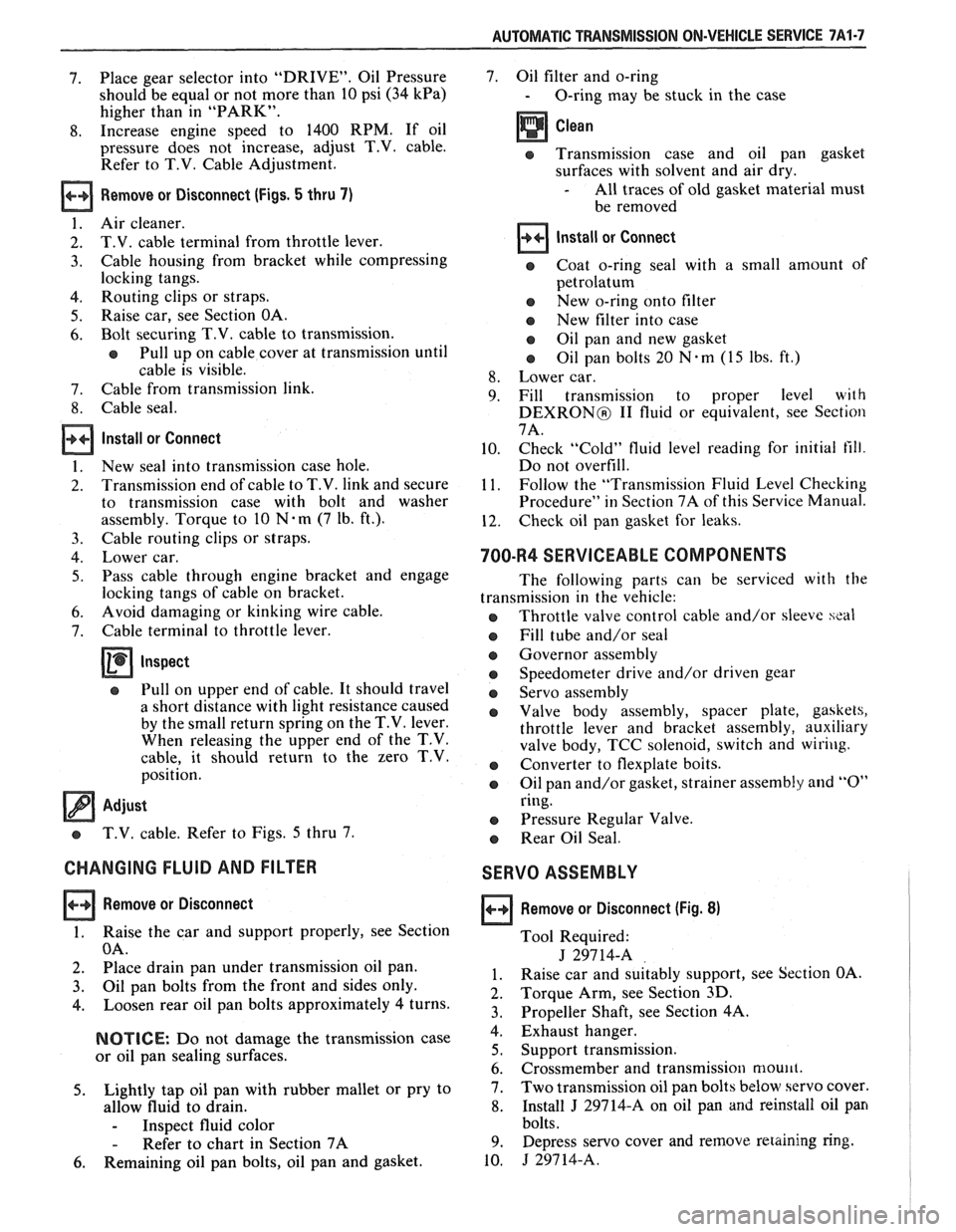
AUTOMATIC TRANSMISSION ON-VEHICLE SERVICE 7A1-7
7. Place
gear selector into "DRIVE". Oil Pressure
should be equal or not more than 10 psi
(34 kPa)
higher than in "PARK".
8. Increase engine speed to 1400 RPM. If oil
pressure does not increase, adjust
T.V. cable.
Refer to T.V. Cable Adjustment.
Remove or Disconnect (Figs. 5 thru 7)
1. Air cleaner.
2. T.V. cable terminal from throttle lever.
3. Cable housing from bracket while compressing
locking tangs.
4. Routing clips or straps.
5. Raise
car, see Section OA.
6. Bolt securing T.V. cable to transmission.
o Pull up on cable cover at transmission until
cable is visible.
7. Cable from transmission link.
8. Cable seal.
Install or Connect
1. New seal into transmission case hole.
2. Transmission end of cable to T.V. link and secure
to transmission case with bolt and washer
assembly. Torque to 10
Nam (7 Ib. ft.).
3. Cable routing clips or straps.
4. Lower car.
5. Pass cable through engine bracket and engage
locking tangs of cable on bracket.
6. Avoid damaging or kinking wire cable.
7. Cable terminal to throttle lever.
Inspect
o Pull on upper end of cable. It should travel
a short distance with light resistance caused
by the small return spring on the
T.V. lever.
When releasing the upper end of the T.V.
cable, it should return to the zero T.V.
position.
Adjust
o T.V. cable. Refer to Figs. 5 thru 7.
CHANGING FLUID AND FILTER
Remove or Disconnect
1. Raise the car and support properly, see Section
OA.
2. Place drain pan under transmission oil pan.
3. Oil pan bolts from the front and sides only.
4. Loosen rear oil pan bolts approximately 4 turns.
NOTICE: Do not damage the transmission case
or oil pan sealing surfaces.
5. Lightly tap oil pan with rubber mallet or pry to
allow fluid to drain.
- Inspect fluid color
- Refer to chart in Section 7A
6. Remaining oil pan bolts, oil pan and gasket. 7. Oil filter
and o-ring
- O-ring may be stuck in the case
e Transmission case and oil pan gasket
surfaces with solvent and air dry.
- All traces of old gasket material must
be removed
Install or Connect
o Coat o-ring seal with a small amount of
petrolatum
o New o-ring onto filter
e New filter into case
a Oil pan and new gasket
e Oil pan bolts 20 N.m (15 lbs. ft.)
8. Lower car.
9. Fill transmission to proper level with
DEXRONO I1 fluid or equivalent, see Section
7A.
10. Check "Cold"
fluid level reading for initial till.
Do not overfill.
11. Follow
the "Transmission Fluid Level Checking
Procedure" in Section 7A of this Service Manual.
12. Check
oil pan gasket for leaks.
700-R4 SERVICEABLE COMPONENTS
The following parts can be serviced with the
transmission in the vehicle:
o Throttle valve control cable and/or sleeve heal
Fill tube and/or seal
o Governor assembly
a Speedometer drive and/or driven gear
e Servo assembly
a Valve body assembly, spacer plate, gaskets,
throttle lever and bracket assembly, auxiliary
valve body, TCC solenoid, switch and
wir-iug.
a Converter to flexplate bolts.
a Oil pan and/or gasket, strainer assembly and "0"
ring.
e Pressure Regular Valve.
o Rear Oil Seal.
SERVO ASSEMBLY
Remove or Disconnect (Fig. 8)
Tool Required:
J 29714-A
1. Raise car and suitably support, see Section OA.
2. Torque Arm,
see Section
3D.
3. Propeller Shaft, see Section 4A.
4. Exhaust hanger.
5. Support transmission.
6. Crossmember and transmission moulll.
7. Two
transmission oil pan bolts below servo cover.
8. Install J 29714-A on oil pan and reinstall oil pan
bolts.
9. Depress servo cover
and remove retaining ring.
10. J 29714-A.
Page 1130 of 1825
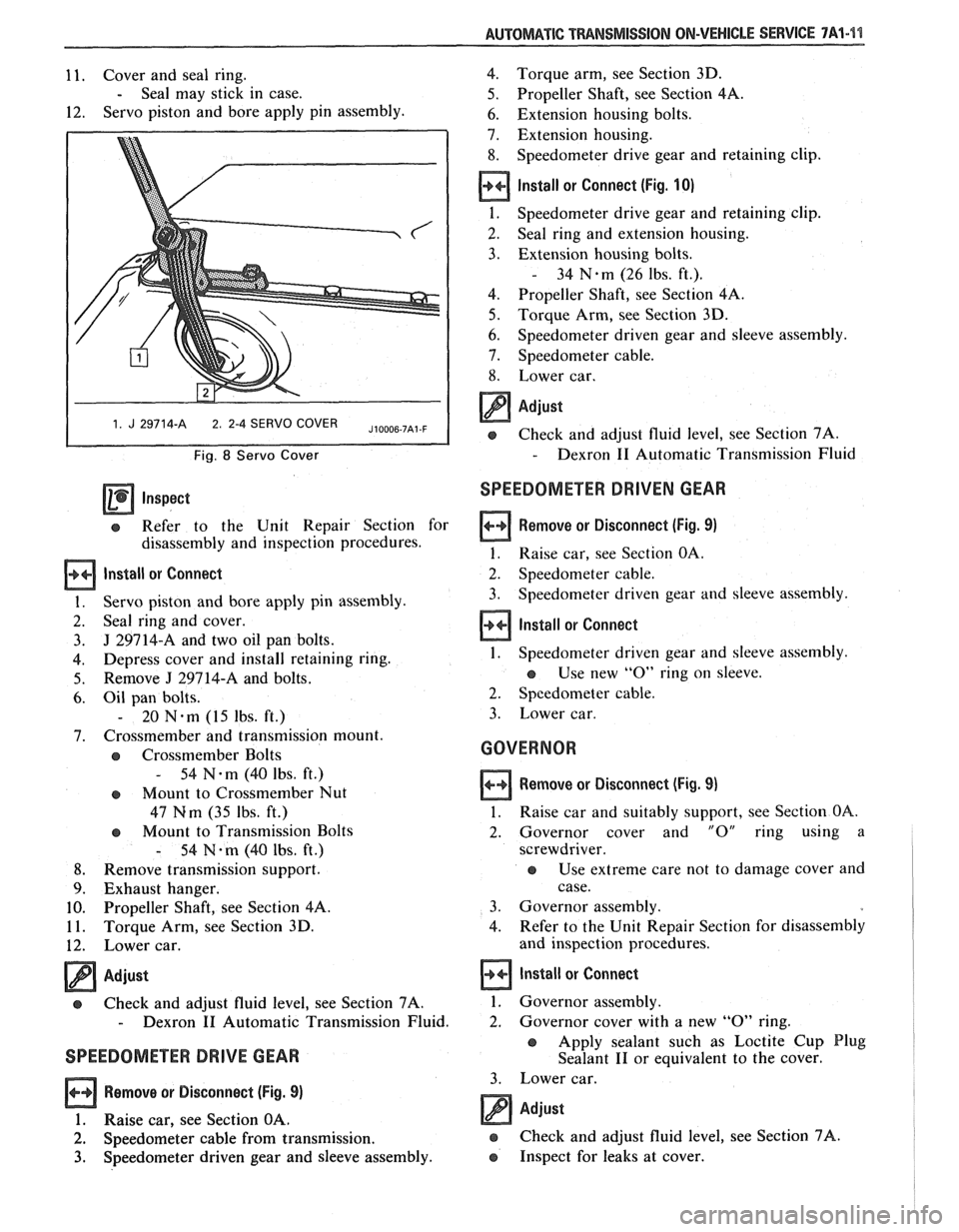
AUTOMATIC TMNSMISSIOM ON-VEHICLE SERVICE 7A1-%I
11. Cover and seal ring.
- Seal may stick in case.
12. Servo
piston and bore apply pin assembly.
1 1. J 29714-A 2 2-4 SERVO COVER I
Fig. 8 Servo Cover
Inspect
e Refer to the Unit Repair Section for
disassembly and inspection procedures.
lnstall or Connect
Servo piston and bore apply pin assembly.
Seal ring and cover.
J 29714-A and two oil pan bolts.
Depress cover and install retaining ring.
Remove
J 29914-A and bolts.
Oil pan bolts.
- 20 N-m (15 lbs. ft.)
Crossmember and transmission mount.
Crossmember Bolts
- 54 N-m (40 Ibs. ft.)
e Mount to Crossmember Nut
47 Nm (35
Ibs. ft.)
e Mount to Transmission Bolts
- 54 N-m (40 lbs. ft.)
Remove transmission support.
Exhaust hanger.
Propeller Shaft, see Section 4A.
Torque Arm, see Section 3D.
Lower car.
Adjust
a Check and adjust fluid level, see Section 7A.
- Dexron I1 Automatic Transmission Fluid.
SPEEDOMETER DRIVE GEAR
Remove or Disconnect (Fig. 9)
1. Raise car, see Section OA.
2. Speedometer cable from transmission.
3. Speedometer driven gear and sleeve assembly. 4.
Torque arm, see Section 3D.
5. Propeller Shaft, see Section
4A.
6. Extension housing bolts.
7. Extension housing.
8. Speedometer drive gear and retaining clip.
Install or Connect (Fig. 10)
1.
Speedometer drive gear and retaining clip.
2. Seal
ring and extension housing.
3. Extension housing bolts.
- 34 N.m (26 Ibs. ft.).
4. Propeller Shaft, see Section 4A.
5. Torque Arm, see Section 3D.
6. Speedometer driven gear and sleeve assembly.
7. Speedometer cable.
8. Lower car.
a Adjust
e Check and adjust fluid level, see Section 7A.
- Dexron I1 Automatic Transmission Fluid
SPEEDOMETER DRIVEN GEAR
Remove or Disconnect (Fig. 9)
1. Raise car, see Section OA.
2. Speedometer cable.
3. Speedometer
driven gear and sleeve assembly.
Install or Connect
1. Speedometer driven gear and sleeve assembly.
a Use new "0" ring on sleeve.
2. Speedometer cable.
3. Lower car.
GOVERNOR
Remove or Disconnect (Fig. 9)
1. Raise car and suitably support, see Section OA.
2. Governor cover and "0" ring using
a
screwdriver.
e Use extreme care not to damage cover and
case.
3. Governor assembly.
4. Refer to the Unit Repair Section for disassembly
and inspection procedures.
Install or Connect
1. Governor assembly.
2. Governor
cover with a new
"0" ring.
e Apply sealant such as Loctite Cup Plug
Sealant
I1 or equivalent to the cover.
3. Lower car.
Adjust
e Check and adjust fluid level, see Section 7A.
e Inspect for leaks at cover.